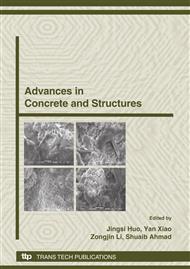p.3
p.17
p.27
p.37
p.43
p.55
p.69
Selective Use of High Performance Cementitious Composites in Concrete Structures
Abstract:
Recent advancements in concrete science and technology have made possible the development of high performance fiber reinforced cementitious composites (HPFRCC) with excellent mechanical properties and long-term durability. However, the costs of these materials are many times that of conventional concrete and the construction of complete structures with them is hard to justify. The strategic application of high performance materials, in selected parts of concrete structures, can bring along higher performance/cost and wider acceptance of the material in practice. This paper will investigate several examples of selective HPFRCC application, including the fabrication of permanent formwork for durability enhancement, the replacement of steel reinforcements at the anchorage zone of post-tensioned members to relieve the steel congestion problem as well as the development of simple and narrow joints for pre-cast concrete members. Based on the experimental results obtained so far, the selected use of HPFRCC in concrete structures appears to have good potential for practical applications.
Info:
Periodical:
Pages:
27-36
Citation:
Online since:
October 2008
Authors:
Keywords:
Price:
Сopyright:
© 2009 Trans Tech Publications Ltd. All Rights Reserved
Share:
Citation:


